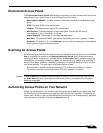
Wireless > Virtual Access Point
496
SonicOS 5.8.1 Administrator Guide
to scale their existing wireless LAN infrastructure to provide differentiated levels of service.
With the Virtual APs (VAP) feature, multiple VAPs can exist within a single physical AP in
compliance with the IEEE 802.11 standard for the media access control (MAC) protocol layer
that includes a unique Basic Service Set Identifier (BSSID) and Service Set Identified (SSID).
This allows for segmenting wireless network services within a single radio frequency footprint
of a single physical access point device.
VAPs allow the network administrator to control wireless user access and security settings by
setting up multiple custom configurations on a single physical interface. Each of these custom
configurations acts as a separate (virtual) access point, and can be grouped and enforced on
a single internal wireless radio.
For more information on SonicOS Secure Wireless features, refer to the SonicWALL Secure
Wireless Integrated Solutions Guide.
Benefits of Using Virtual APs
This section includes a list of benefits in using the Virtual AP feature:
• Radio Channel Conservation—Prevents building overlapped infrastructures by allowing
a single Physical Access Point to be used for multiple purposes to avoid channel collision
problem. Channel conservation. Multiple providers are becoming the norm within public
spaces such as airports. Within an airport, it might be necessary to support an FAA
network, one or more airline networks, and perhaps one or more Wireless ISPs. However,
in the US and Europe, 802.11b networks can only support three usable (non-overlapping)
channels, and in France and Japan only one channel is available. Once the channels are
utilized by existing APs, additional APs will interfere with each other and reduce
performance. By allowing a single network to be used for multiple purposes, Virtual APs
conserve channels.
• Optimize Wireless LAN Infrastructure—Share the same Wireless LAN infrastructure
among multiple providers, rather than building an overlapping infrastructure, to lower down
the capital expenditure for installation and maintenance of your WLANs.
Wireless Virtual AP Configuration Task List
A Wireless VAP deployment requires several steps to configure. The following section provides
first a brief overview of the steps involved, and then a more in-depth examination of the parts
that make up a successful VAP deployment. This subsequent sections describe VAP
deployment requirements and provides an administrator configuration task list:
• “Wireless VAP Overview” section on page 495
• “Network Zones” section on page 498
• “Wireless LAN Subnets” section on page 502
• “DHCP Server Scope” section on page 503
• “Deploying VAPs to the Wireless Radio” section on page 511


















